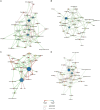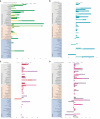Volunteer programs, empowerment, and life satisfaction in Jordan: mapping local knowledge and systems change to inform public policy and science diplomacy
- PMID: 38873342
- PMCID: PMC11170447
- DOI: 10.3389/fsoc.2024.1371760
Volunteer programs, empowerment, and life satisfaction in Jordan: mapping local knowledge and systems change to inform public policy and science diplomacy
Abstract
Introduction: Volunteering in the community is thought to provide unique benefits to people who experience limited engagement in society. In the global South, volunteer programs are often framed as empowering women and benefiting the poor, without empirical evidence or systematic investigation of what this means from a local perspective. For this reason, it is critical to represent stakeholder knowledge, understand how change happens systemically, and reduce cultural bias in scientific inquiry and public policy. As such, efforts to respect diverse narratives and problem-solving approaches are key to science diplomacy - they help us understand cultural relevance, program efficacy, and for whom a program is considered transformative.
Methods and results: This study shows how Syrian refugee and Jordanian women, living in resource-poor families, articulated (i) concepts of empowerment and life satisfaction and (ii) the benefits of engaging in community-based volunteering programs. Through engaging in a participatory methodology known as Fuzzy Cognitive Mapping, women generated visual representations of these constructs and cause-and-effect reasoning. They identified several dimensions of empowerment (e.g., cultural, financial, and psychological empowerment) and several meanings of life satisfaction (e.g. adaptation, acceptance, and contentment). They also mapped connections between variables, identifying those that might catalyze change. We were specifically interested in evaluating understandings of We Love Reading, a program that trains volunteers to become changemakers in their local community. In simulations, we modelled how employment, education, money, and volunteering would drive system change, with notable results on cultural empowerment.
Discussion: Through visual maps and scenarios of change, the study demonstrates a participatory approach to localizing knowledge and evaluating programs. This is key to improving scientific enquiry and public policy.
Keywords: cognitive mapping; empowerment; life satisfaction; participatory research; policy; refugee; systems change; volunteer.
Copyright © 2024 Panter-Brick, Qtaishat, Eggerman, Thomas, Kumar and Dajani.
Conflict of interest statement
LQ was employed by Taghyeer Organization. The remaining authors declare that the research was conducted in the absence of any commercial or financial relationships that could be construed as a potential conflict of interest.
Figures



Similar articles
-
Mapping the perceived impacts of a social innovation program on women's agency and life satisfaction.Front Sociol. 2025 Feb 14;10:1527841. doi: 10.3389/fsoc.2025.1527841. eCollection 2025. Front Sociol. 2025. PMID: 40027158 Free PMC article.
-
Does volunteering impact refugee women's life satisfaction, empowerment, and wellbeing? Experimental evidence, local knowledge, and causal reasoning.Soc Sci Med. 2024 Apr;347:116735. doi: 10.1016/j.socscimed.2024.116735. Epub 2024 Mar 2. Soc Sci Med. 2024. PMID: 38552338
-
Pathways to Civic Engagement Among Urban Youth of Color.Monogr Soc Res Child Dev. 2020 Jun;85(2):7-154. doi: 10.1111/mono.12415. Monogr Soc Res Child Dev. 2020. PMID: 32394514
-
Impact of summer programmes on the outcomes of disadvantaged or 'at risk' young people: A systematic review.Campbell Syst Rev. 2024 Jun 13;20(2):e1406. doi: 10.1002/cl2.1406. eCollection 2024 Jun. Campbell Syst Rev. 2024. PMID: 38873396 Free PMC article. Review.
-
A review of different types of volunteer programs for older adults with and without cognitive impairment.Front Public Health. 2023 Jun 15;11:1164952. doi: 10.3389/fpubh.2023.1164952. eCollection 2023. Front Public Health. 2023. PMID: 37397711 Free PMC article. Review.
Cited by
-
Mapping the perceived impacts of a social innovation program on women's agency and life satisfaction.Front Sociol. 2025 Feb 14;10:1527841. doi: 10.3389/fsoc.2025.1527841. eCollection 2025. Front Sociol. 2025. PMID: 40027158 Free PMC article.
-
Measuring life satisfaction of self-help groups: Role of perceived social support and social empowerment.F1000Res. 2025 Mar 6;14:101. doi: 10.12688/f1000research.148209.2. eCollection 2025. F1000Res. 2025. PMID: 40151337 Free PMC article.
References
-
- Ait Ali Slimane M., Lundvall J., Mohindra K., Al Abbadi S., Kurshitashvili N., Hisou O. (2020). “Women’s economic empowerment in Jordan,” in MENA Knowledge and Learning Quick Notes Series. Washington, DC: World Bank. Available at: https://openknowledge.worldbank.org/handle/10986/33587 (Accessed April 27, 2024).
-
- Barbrook-Johnson P., Penn A. S. (2022). “Fuzzy Cognitive Mappping” in Systems mapping: How to build and use causal model systems. eds. Barbrook-Johnson P., Penn A. S. (Palgrave: MacMillan; ), 79–95.
-
- Bennett C. (2018). Constructive deconstruction: Imagining alternative humanitarian action. Humanitarian policy group working paper. London: Overseas Development Institute. Available at: htcultps://cdn.odi.org/media/documents/ 12206.pdf.
-
- Braun V., Clarke V. (2006). Using thematic analysis in psychology. Qual. Res. Psychol. 3, 77–101. doi: 10.1191/1478088706qp063oa - DOI
LinkOut - more resources
Full Text Sources
Research Materials

